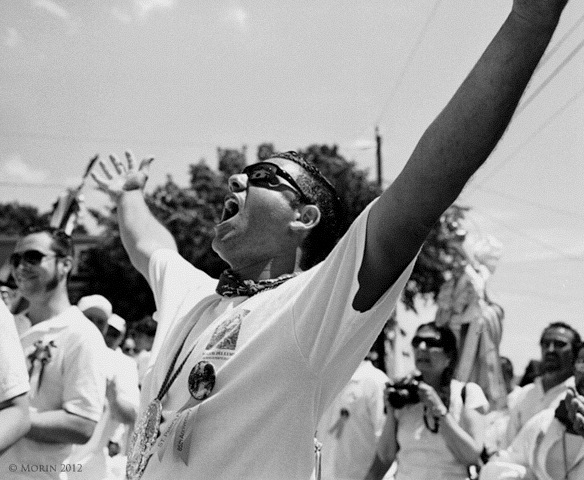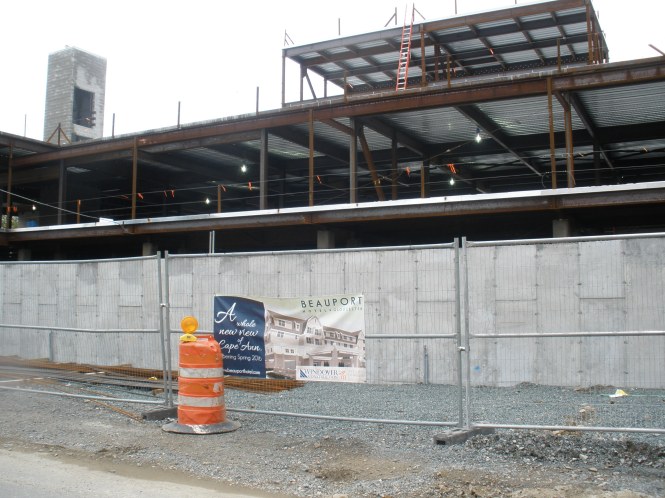by Mike Cook
As July, 3 approaches, I can’t help but hearken back to 1992 when I was living at 51 Fort Square, where I had the honor of being a friend to and, on occasion, taking care of, John Barnes, as he waged his heroic fight against AIDS and then serenely accepted his time had come as he lay comfortably in his bed overlooking Gloucester Harbor and Ten Pound Island.
On July, 3, 1992, it was clear to me and Tanny Martin, our upstairs neighbor and “sister” in the fight against HIV/AIDS, who just happened to be the nurse who coordinated the Visiting Nurses Association of the North Shore’s AIDS home care program, that John was getting ready to leave us.
The previous few days had seen John lapsing more frequently in and out of consciousness. His breathing was becoming more labored, and he would speak openly of how tired he was and how ready he was to move on.
But that said, he never lost his wicked sense of humor. A few nights before his passing, his sister, who was full of anticipatory grief and anxiety, insisted on opening the strong box Johnny kept his personal papers in and had asked be opened only after his death.
John had been sleeping for hours, but almost as soon as his sister opened the box, he opened his eyes and with an impish grin on his face said, “Jesus, Cheryl, you couldn’t even wait til I’m dead!?”
An uncomfortable silence fell briefly over the room, only to be broken by John’s laughter as he told his sister how much he loved her – in spite of her disobedience and nosiness.
By late afternoon on July 3, Tanny encouraged me to take a break, catch some rays on Pavilion Beach, and hang out with coworkers from NUVA at the Horribles Parade.
About mid way through the parade, this intense feeling came over me and I knew I had to get home to 51 -fast. I set out at a full run, trying to make my way through the crowd on the Boulevard – which was no easy task. I was as focused on getting home as I have ever been on anything in my life.
I raced into the Fort and up the hill to 51. As my feet hit the first step, Tanny opened the door and simply said, “He’s gone”.
I went into his room and sat on the edge of his bed. I remember whispering, “You still look like Patrick Swayze, even dead you stud muffin you!”
Tanny was in the kitchen on the phone with Dr. Doug Fiero. As an RN, she was able, with Doug collaborating, to declare John dead.
She then called John’s mom who asked if Tanny would call Greeley’s. John’s mom just could not bring herself to do it.
When Tanny hung up the phone with Greeley’s, she came into the room and said, “They can’t get here for a couple of hours because of the traffic from the parade.”
I looked at Tanny and said, “Now what do we do?”
We got to talking about what John would want to wear at his wake – a ritual he wanted no part of but agreed to because he believed it would help his family, especially his mom, accept the finality of his passing.
So, we went into John’s closet and perused his wardrobe. We both agreed his black leather jeans, a faded denim shirt, a silver and turquoise bolo tie and a leather vest would be the clothes John would want to spend eternity in, perhaps with the multi-colored boa that was in the closet as an accent piece. But we also knew his mother would be mortified at just the thought of her “Glosta” boy being laid out in such an outfit. So we picked out something more “Glosta” for our friend to wear at, what he often called, his “going away party”.
We then settled into a comfortable silence, sitting on different sides of the bed thinking about how much John had done to educate people, especially young people, about the dangers HIV/AIDS could pose to them if they did not educate themselves and make responsible decisions regarding their behavior.
As the sun set, the hearse came around that 90 degree corner in the Fort just beyond the playground and the reality of what had transpired finally settled in on me.
The staff from Greeley’s came in and were a bit taken aback when Tanny and I not only stayed in the room as they placed John in a body bag, but actually assisted them in doing so.
As all this was going on, two other dear friends and neighbors came racing into the house after they had seen the hearse coming into the Fort. One was actually John’s cousin, and the other a neighbor in the Fort who, along with her two little children, had become part of what was and is a kind of extended family.
Her son, in fact, just weeks before John’s death, had walked with me in the AIDS Walk for John – well, he walked three quarters of the way until, as many eight year olds are wont to do, he began to whine about how tired he was – which resulted in me carrying him on my shoulders for what seemed like an endless trek along the banks of the Charles River. When I see that young man today, all six foot three and a rock solid 240 pounds of him, I can’t help but smile warmly at the image of him wearing a tee shirt he designed for the walk that declared John Barnes was his very best friend and would be “..until the end of time..”.
We all stood by the hearse as the men from Greeley’s put John inside, closed the doors, and started the engine.
As the hearse took John away from 51 for the last time, a loud boom shattered the silence and this enormous burst of purple fireworks seemed to light up the entire Fort. Ever one for both dramatic entrances and exits, to this day I think Johnny timed everything to his liking. Purple, after all, was his favorite color.
In the weeks and months after John’s death, several other leaders in the local fight against AIDS, including Sam Berman, who’d served as the director of what was then called the North Shore AIDS Health Project, passed away or saw their health begin to decline dramatically.
On the one hand, those were pretty somber days for people affected by AIDS in Gloucester, not unlike what is happening today for those people and their families who are bearing the brunt of the heroin/prescription opioid epidemic today. But they were also kind of heady days because they were days that saw people come together in the face of a seemingly insurmountable challenge in ways that made Gloucester stand out as a community – not just within Massachusetts, but across the nation.
The level of cooperation and collaboration that emerged in Gloucester, not just between agencies but between various citizen’s groups and volunteer organizations in response to AIDS, actually became models that the MA Department of Public Health held up for other communities to emulate as they struggled with both the epidemic and the turf issues that often arise, especially among service providers, when significant funding becomes available, and the competition for that funding often causes people to take their eyes off the really important stuff. For the most part, that never happened in Gloucester.
I see something like that happening again today in Gloucester in the face of the heroin/prescription opioid epidemic currently roiling the city. The overall positive response to Chief Campanello’s innovative and courageous shift in police policy regarding drug addiction and the people devastated by it, and the kinds of collaborative efforts between professional service providers, people in recovery, and ordinary Gloucester folk who’ve recognized the old approaches to the drug and addiction issue have failed, are strikingly similar to the kinds of collaboration and cooperation of two decades ago.
As a result Gloucester is, once again, being viewed by other communities, especially here on Cape Cod where the heroin/prescription opioid epidemic is as severe as it is in Gloucester, as a community to emulate in terms of how to address the drug/addiction issue. Chief Campanello’s actions and the response of the wider community have been the topics of both individual conversations and news stories here – most all of them positive.
Gloucester is, once again, showing itself to be a leader in the face of a controversial issue that many people either do not understand or would rather not talk about because they mistakenly view the issue solely through the lens of morality or criminality as opposed to the public health issue it really is.
But beyond Gloucester’s responses to health crises like AIDS and addiction, the kind of community spirit and activism that fueled those responses needs to be tapped into again in the face of the huge socioeconomic and demographic changes bearing down on Gloucester as the decline of the fishing industry leaves Gloucester vulnerable to the kinds of gentrification, real estate speculation, and false belief that a “visitor based” tourism economy is the key to a sustainable future for all the city’s residents.
Nothing, absolutely nothing could be further from the truth.
Anyone who doubts that assertion should just look, as I have said before, at what has happened to once socioeconomically diverse coastal communities like Provincetown, Nantucket, and Newburyport.
But what motivated me to write this was a desire, even from a distance, to remind people of what I told John 24 years ago when we lived together at 51. It was then I told him that, if people didn’t keep their guard up, someone with very deep pockets was going to descend on Gloucester and transform a vibrant, ethnic working class, waterfront neighborhood like Fort Square into little more then an upscale, exclusive harbor front version of Louisburg Square by the Sea,
That someone has arrived and the process is well underway. The only question now is, “How far will people let that process go and will it be allowed to remake Gloucester into little more than a clone of Newburyport, Provincetown, and Nantucket – where the economies are largely based, to paraphrase Peter Anastas, on the “chimera” of tourism, but the workers in that industry can no longer afford to live in the community where they work?”
People need to be thinking long and hard about that question because the clock is ticking as to whether or not keeping a semblance of the “enduring Gloucester” we love so much is even a possibility.
Still, I am betting Gloucester, given her big heart and even bigger soul, will yet find a way to navigate the social and economic changes bearing down upon her so that she remains a coastal city where all are welcome and able to live and raise their families – not just a select, well heeled few.

Mike Cook is a long time liberal and gay rights activist who saw the uniqueness of Gloucester from the first moment he drove over the bridge during his move from Cambridge to Cape Ann in 1991 to run NUVA’s AIDS education and services programs.













 Melissa de Haan Cummings majored in French and English Literature at
Bryn Mawr. She has published poetry in a number of journals.
She describes her interests as including, “much small boating around Cape
Ann, love of Charles Olson, Hatha yoga practice since 1969."
Melissa de Haan Cummings majored in French and English Literature at
Bryn Mawr. She has published poetry in a number of journals.
She describes her interests as including, “much small boating around Cape
Ann, love of Charles Olson, Hatha yoga practice since 1969."


















